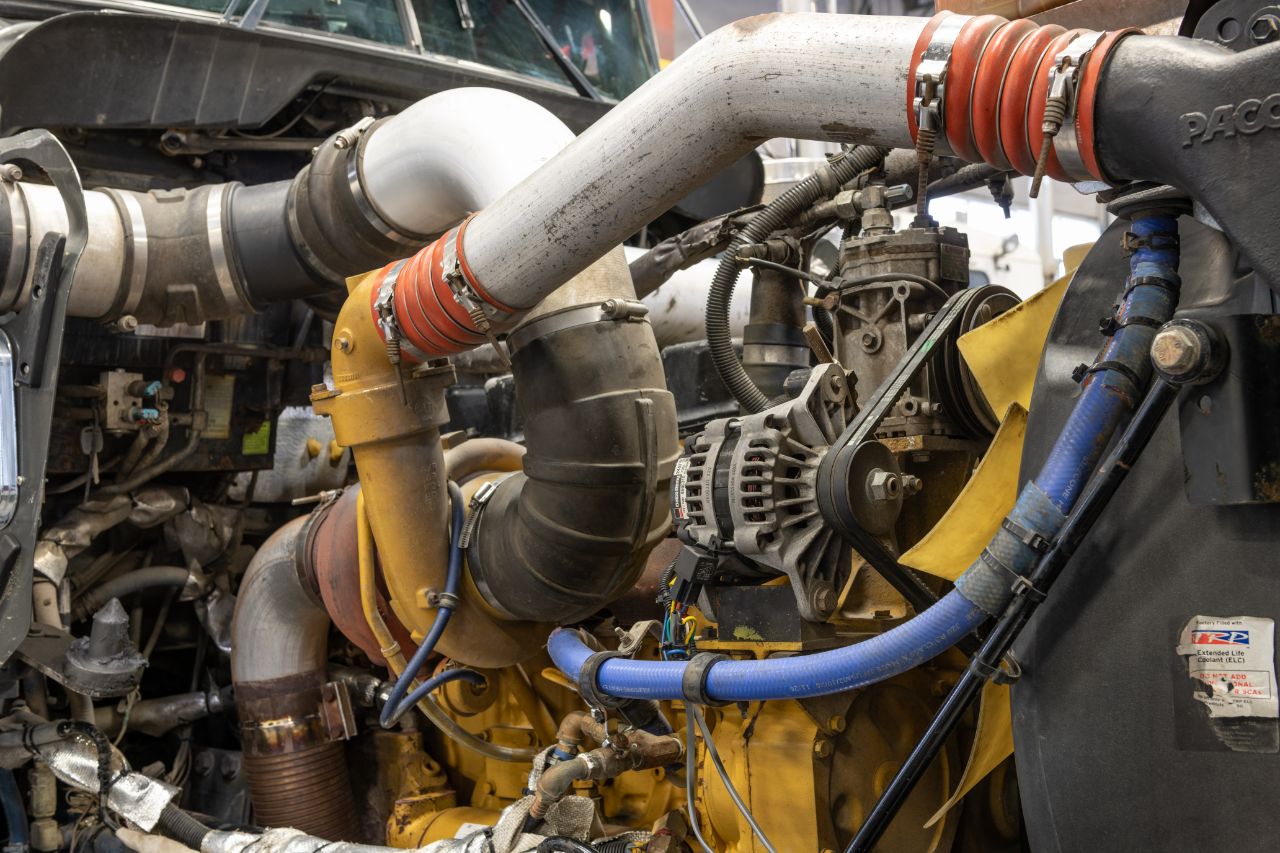Learn how to keep your semi truck's exhaust and emission system in peak condition. This guide covers DPF, SCR, EGR, sensors, and turbo maintenance to boost performance, meet regulations, and protect your engine.

Understanding the Exhaust and Emissions System
What Does the Exhaust System Do?
Your semi truck’s exhaust system is responsible for directing harmful gases—like carbon monoxide, nitrogen oxides (NOx), and hydrocarbons—away from the engine and out the tailpipe. It begins at the exhaust manifold and typically includes:
- Exhaust manifold: Collects gases from the cylinders.
- Turbocharger (if equipped): Utilizes exhaust energy to boost engine performance.
- Diesel Oxidation Catalyst (DOC): Converts carbon monoxide and hydrocarbons into carbon dioxide and water vapor.
- Diesel Particulate Filter (DPF): Captures soot and particulates.
- Selective Catalytic Reduction (SCR) system: Converts NOx into nitrogen and water using Diesel Exhaust Fluid (DEF).
- Muffler: Reduces sound before releasing the exhaust gas.
The Purpose of Emission Systems
The emission system aims to reduce pollutants released into the atmosphere. Key components include:
- EGR (Exhaust Gas Recirculation) system: Lowers combustion temperature to reduce NOx.
- DOC and DPF: Trap and eliminate carbon and particulate matter.
- SCR: Neutralizes NOx using DEF injections.
- Sensors: Monitor pressure, temperature, and emissions levels to regulate system performance.
Critical Maintenance Practices
1. Monitor and Clean the Diesel Particulate Filter (DPF)
Your DPF traps carbon-based particulates and must periodically undergo regeneration, a process that burns off accumulated soot. There are two types:
- Passive Regeneration: Occurs during high-speed highway driving.
- Active/Forced Regeneration: Triggered when sensors detect high soot load.
Neglecting regeneration can lead to clogs, back pressure issues, and even engine derating.
2. Maintain the Selective Catalytic Reduction (SCR) System
The SCR system relies on DEF (diesel exhaust fluid) to function properly. If the DEF tank runs dry or DEF quality is poor, your truck will experience reduced power or even shut down. Key maintenance includes:
- Topping off DEF regularly.
- Using only high-quality, uncontaminated DEF.
- Replacing DEF filters as recommended.
3. Inspect and Clean Sensors
Pressure, temperature, and NOx sensors are critical for efficient exhaust system operation. Dirty or failed sensors can trigger fault codes and interfere with regeneration cycles.
Recommended actions:
- Clean soot sensors during scheduled maintenance.
- Replace sensors showing signs of failure or erratic readings.
4. Check for Exhaust Leaks
Exhaust leaks often occur at joints, clamps, or the manifold. Common symptoms include:
- Hissing sounds or a strong exhaust odor in the cab.
- Black soot accumulation near gaskets or bolts.
- Loss of turbo boost pressure.
Leaks can allow harmful gases into the cab and skew sensor readings, impairing emissions control.
5. Inspect Turbocharger Functionality
For trucks equipped with a turbocharger, it’s essential to ensure it’s not leaking oil or underperforming. A sluggish turbo can compromise aftertreatment system efficiency, leading to excessive emissions.
Keep an eye out for:
- Reduced power and sluggish acceleration.
- Excessive black smoke.
- Oil residue in the intercooler or exhaust path.
6. Keep the DOC and EGR Systems Clean
The DOC can become clogged with ash and soot over time, and the EGR valve and cooler can build up carbon deposits, reducing airflow and cooling efficiency.
Maintenance tips:
- Periodic cleaning or replacement of the DOC.
- EGR valve and cooler should be inspected and cleaned during major services.
Signs of a Failing Exhaust or Emission System
Failure in any part of your emissions system can drastically reduce your truck's performance. Be on alert for:
- Check engine lights with fault codes like P2002 (DPF Efficiency Below Threshold).
- Excessive black or white smoke.
- Decreased fuel economy.
- Engine derating or limp mode.
Frequency of Maintenance
A preventive approach ensures maximum uptime. A good rule of thumb includes:
- DPF cleaning: Every 150,000–250,000 miles, depending on duty cycle.
- DEF filter replacement: Every 200,000 miles or per OEM spec.
- Sensor inspection and software updates: At each PM service interval.
- Exhaust leak checks: Quarterly or during BIT inspections.
Compliance with Regulations
Non-compliance with emissions standards can lead to:
- Heavy fines.
- Failed roadside inspections.
- Downtime due to enforced repairs.
By staying on top of aftertreatment system maintenance, you ensure that your semi truck remains compliant and roadworthy.
Conclusion
Maintaining your semi truck exhaust and emission system is critical. From DPF regeneration and SCR maintenance to turbocharger inspections and sensor replacements, each component plays a vital role. Don’t overlook the importance of regular checks and cleanings—your engine, wallet, and the environment will thank you.
Contact Gogo Diesel Repair in Spartanburg, SC, for expert emission system diagnostics, DPF cleaning, and aftertreatment system services.
News & Articles
Here, you'll find regular articles covering a wide range of topics related to diesel repair, maintenance, and troubleshooting.
Recent Customer Reviews
"GOGO DIESEL IS THE PLACE I GO EVEN IF I HAVE TO DRIVE EXTRA MILE. HARD WORKING GUYS. HONEST. WON'T CUT CORNERS, VERY KNOWLEDGEABLE.Thanks Daniel for your help doing/going extra mile"
"Good job, professional man who respects his work. As long as i work in this area, he will remain the first choice. Thank you, good work."
"Best of best"
Contact Gogo Diesel Repair
Gogo Diesel Repair provides experienced heavy-duty truck repair services, both in-shop & via mobile service, to Spartanburg, SC & the surrounding areas. Contact us today for additional info, to request an estimate, and to schedule service.

